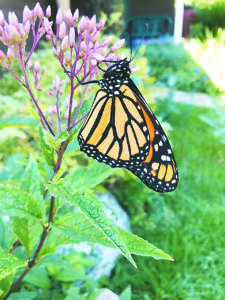By David Fleet
Editor
Goodrich — Their distinctive orange wings with black stripes are the ever common monarch butterfly, a familiar summer visitor to Michigan.
a familiar summer visitor to Michigan.
However, the milkweed loving winged passerby needs some help.
In July, the International Union for the Conservation of Nature (IUCN) reported the migrating monarch butterfly, common in southeastern Michigan, was added to its “red list” of threatened species and categorized it as “endangered,” just two steps from extinction.
The IUCN estimates that the population of monarch butterflies in North America has declined between 22 percent and 72 percent over 10 years.
Dr. Elise Zipkin, a quantitative ecologist at Michigan State University along with other researchers are taking action.
“It’s really hard to say exactly how much monarchs have declined because they are dispersed over very large areas so it is impossible to do a standard census,” said Zipkin, during an interview with The Citizen last week.
“The estimate of 22-72 percent is rather large. Research suggests that it is somewhere in that ballpark dating back to about the mid 1990s.”
The monarch butterfly population drops are attributed to several factors including habitat loss, climate change, along with an increased use of herbicides and pesticides for agriculture.
“Under current climate projections, northern Ohio and southern Michigan are projected to do reasonably well in the short term, better than other areas of the Midwest that may be warming faster (farther north) or getting drier (farther west),” said Zipkin. “This may lead our area to be somewhat of a climate refuge for monarchs over the next 20 years or so.”
Angie Adamec, a Goodrich resident, said a few plants will help the monarch survive and sustain its future.
“Across the country individuals have been planting nectar gardens for our pollinators, but especially so for our monarch butterfly who will soon be traveling great distances to get to their overwintering forests in the far south,” she said.
Good pollinator plants would be common milkweed, swamp milkweed and butterfly milkweed for both monarch egg laying and all around nectar. Nectar plants would be blazing star, autumn sedum, bergamot, monarda, threadleaf coreopsis, columbine, Joe pye weed and anise hyssop to name a few.
Zipkin agrees habitat is key in the monarchs survival.
“Property owners can focus on planting native species in their yards or any open areas of land,” said Zipkin. “Lots of southern Michigan use to have large open areas of land, including prairies. Planting those species that are native to your particular area will do a ton to help pollinators, migratory species and all other kinds of wildlife that evolved in these habitats.”
However, what happens to monarchs in the future will be determined by how much more climate change our planet experiences, she added.
“The best way to ensure the long term sustainability of monarchs in Michigan is to take steps to reign in climate change through reduced fossil fuel emissions at global levels.”
You can learn more about what milkweeds are native to your county here: https://www.xerces.org/milkweed/milkweed-seed-finder
